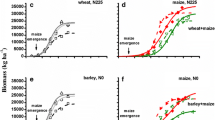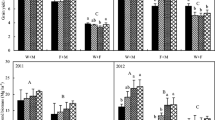Abstract
Interspecific interactions and soil nitrogen supply levels affect intercropping productivity. We hypothesized that interspecific competition can be alleviated by increasing N application rate and yield advantage can be obtained in competitive systems. A field experiment was conducted in Wuwei, Gansu province in 2007 and 2008 to study intercropping of faba bean/maize, wheat/maize, barley/maize and the corresponding monocultures of faba bean (Vicia faba L.), wheat (Triticum aestivum L.), barley (Hordeum vulgare L.) and maize (Zea mays L.) with N application rates of 0, 75, 150, 225 and 300 kg N ha−1. Total land equivalent ratios (TLER) were 1.22 for faba bean/maize, 1.16 for wheat/maize, and 1.13 for barley/maize intercropping over the 2-year study period. Maize was overyielding when intercropped with faba bean, but underyielding when intercropped with wheat or barley according to partial land equivalent ratios (PLER) based on grain yields of individual crops in intercropping and sole cropping. There was an interspecific facilitation between intercropped faba bean and maize, and interspecific competition between maize and either wheat or barley. The underyielding of maize was higher when intercropped with barley than with wheat. Fertilizer N alleviated competitive interactions in intercrops with adequate fertilizer N at 225 kg ha−1. Yield advantage of intercropping can be acquired with adequate nitrogen supply, even in an intensive competitive system such as barley/maize intercropping. This is important when using intercropping to develop intensive farming systems with high inputs and high outputs.


Similar content being viewed by others
References
Allen JR, Obura K (1983) Yield of corn, cowpea, and soybean under different intercropping systems. Agron J 75:1005–1009
Andersen MK, Hauggaard-Nielsen H, Ambus P, Jensen ES (2004) Biomass production, symbiotic nitrogen fixation and inorganic N use in dual and tri-component annual intercrops. Plant Soil 266:273–287
Caballero R, Goicoechea EL, Hernaiz PJ (1995) Forage yields and quality of common vetch and oat sown at varying seeding ratios and seeding rates of vetch. Field Crop Res 41:135–140
Cahill JF (2002) What evidence is necessary in studies which separate root and shoot competition along productivity gradients? J Ecol 90:201–205
Carr PM, Horsley RD, Poland WW (2004) Barley, oat, and cereal-pea mixtures as dryland forages in the Northern Great Plains. Agron J 96:677–684
Chowdhury MK, Rosario EL (1994) Comparison of nitrogen, phosphorus and potassium utilization efficiency in maize mungbean intercropping. J Agric Sci 122:193–199
Firbank LG, Watkinson AR (1990) On the effects of competition: from monocultures to mixtures. In: Grace JB, Tilman D (eds) Perspectives on plant competition. Academic, London, pp 165–192
Francis CA (1985) Intercropping-competition and yield advantage. In: Shibles R (ed) World soybean research conference III. Westview Press, Boulder, CO, pp 1017–1024
Gahukar RT (1989) Pest and disease incidence in pearl-millet under different plant-density and intercropping patterns. Agric Ecosyst Environ 26:69–74
Ghosh PK (2004) Growth, yield, competition and economics of groundnut/cereal fodder intercropping systems in the semi-arid tropics of India. Field Crop Res 88:227–237
Ghosh PK, Bandyopadhyay KK, Wanjari RH, Manna MC, Misra AK, Mohanty M, Rao AS (2007) Legume effect for enhancing productivity and nutrient use-efficiency in major cropping systems—an Indian perspective: a review. J Sustain Agric 30:59–86
Grime JP (1979) Plant strategies and vegetation processes. Wiley, Chichester
Harris D, Natarajan M, Willey RW (1987) Physiological basis for yield advantage in a sorghum/groundnut intercrop exposed to drought. 1. Dry-matter production, production, yield and light interception. Field Crops Res 17:259–272
Hauggaard-Nielsen H, Jensen ES (2001) Evaluating pea and barley cultivars for complementarity in intercropping at different levels of soil N availability. Field Crops Res 72:185–196
Horst WJ, Waschkies C (1987) Phosphorus nutrition of spring wheat (Triticum aestivum L.) in mixed culture with white lupin (Lupinus albus L.). Z Pflanzernähr Bodenkd 150:1–8
Jensen ES (1996) Grain yield, symbiotic N-2 fixation and interspecific competition for inorganic N in pea-barley intercrops. Plant Soil 182:25–38
Kavamahanga F, Bishnoi UR, Aman K (1995) Influence of different N rates and intercropping methods on grain sorghum, common bean, and soya bean yields. Trop Agric 72:257–260
Keddy PA (1989) Competition. Chapman and Hall, New York
Knudsen MT, Hauggaard-Nielsen H, Jornsgard B, Jensen ES (2004) Comparison of interspecific competition and N use in pea-barley, faba bean-barley and lupin-barley intercrops grown at two temperate locations. J Agric Sci 142:617–627
Li L, Yang SC, Li XL, Zhang FS, Christie P (1999) Interspecific complementary and competitive interactions between intercropped maize and faba bean. Plant Soil 212:205–214
Li L, Sun JH, Zhang FS, Li XL, Yang SC, Rengel Z (2001a) Wheat/maize or wheat/soybean strip intercropping I. Yield advantage and interspecific interactions on nutrients. Field Crop Res 71:123–137
Li L, Sun JH, Zhang FS, Li XL, Rengel Z, Yang SC (2001b) Wheat/maize or wheat/soybean strip intercropping II. Recovery or compensation of maize and soybean after wheat harvesting. Field Crop Res 71:173–181
Li L, Sun JH, Zhang FS, Guo TW, Bao XG, Smith FA, Smith SE (2006) Root distribution and interactions between intercropped species. Oecologia 147:280–290
Li L, Li SM, Sun JH, Zhou LL, Bao XG, Zhang HG, Zhang FS (2007) Diversity enhances agricultural productivity via rhizosphere phosphorus facilitation on phosphorus-deficient soils. Proc Natl Acad Sci USA 104:11192–11196
Li YY, Yu CB, Cheng X, Li CJ, Sun JH, Zhang FS, Lambers H, Li L (2009) Intercropping alleviates the inhibitory effect of N fertilization on nodulation and symbiotic N-2 fixation of faba bean. Plant Soil 323:295–308
Liu GC (2005) Difference and its mechanism of interspecific nutrition competition in different intercropping systems. Dissertation, Gansu Agricultural University, China
Loreau M, Naeem S, Inchausti P, Bengtsson J, Grime JP, Hector A, Hooper DU, Huston MA, Raffaelli D, Schmid B, Tilman D, Wardle DA (2001) Biodiversity and ecosystem functioning: current knowledge and future challenges. Science 294:804–808
Lu LS (1999) The introduction of the comprehensive multistoried and dimension agriculture in China. Sichuan Science and Technology Press (in Chinese, with English preface)
Mohsenabadi GR, Jahansooz MR, Chaichi MR, Mashhadi HR, Liaghat AM, Savaghebi GR (2008) Evaluation of barley-vetch intercrop at different nitrogen rates. J Agric Sci Technol 10:23–31
Morris RA, Garrity DP (1993) Resource capture and utilization in intercropping: non-nitrogen nutrient. Field Crops Res 34:319–334
Murphy GP, Dudley SA (2007) Above-and below-ground competition cues elicit independent responses. J Ecol 95:261–272
Natarajan M, Willey RW (1985) Effect of row arrangement on light interception and yield in sorghum pigeonpea intercropping. J Agric Sci 104:263–270
Ndakidemi PA (2006) Manipulating legume/cereal mixtures to optimize the above and below ground interactions in the traditional African cropping systems. Afr J Biotechnol 5:2526–2533
Newman EI (1973) Competition and diversity in herbaceous vegetation. Nature 244:310–311
Olasantan FO (1988) The effects on soil temperature and moisture content and crop growth and yield of intercropping maize with melon (Manihot esculenta). Exp Agric 24:67–74
Rao MR, Willey RW (1980) Evaluation of yield stability in intercropping: studies on sorghum-pigeonpea. Exp Agric 16:105–116
Roberts CA, Moore KJ, Johnson KD (1989) Forage quality and yield of wheat-vetch at different stages of maturity and vetch seeding rates. Agron J 81:57–60
SAS Institute (2001) SAS/STAT User’s Guide, Version 8.0. SAS Institute Cary
Schippers P, Snoeijing I, Kropff MJ (1999) Competition under high and low nutrient levels among three grassland species occupying different positions in a successional sequence. New Phytol 143:547–559
Schmidtke K, Neumann A, Hof C, Rauber R (2004) Soil and atmospheric nitrogen uptake by lentil (Lens culinaris Medik.) and barley (Hordeum vulgare ssp nudum L.) as monocrops and intercrops. Field Crops Res 87:245–256
Sharaiha R, Gliessman S (1992) The effects of crop combination and row arrangement in the intercropping of lettuce, favabean and pea on weed biomass and diversity and on crop yields. Biol Agric Hortic 9:1–13
Snaydon RW (1982) Root and shoot interactions between barley and field beans when intercropped. J Appl Ecol 19:263–272
Songa JM, Jiang N, Schulthess F, Omwega C (2007) The role of intercropping different cereal species in controlling lepidopteran stemborers on maize in Kenya. J Appl Entomol 131:40–49
Thorsted MD, Weiner J, Olesen JE (2006) Above-and below-ground competition between intercropped winter wheat Triticum aestivum and white clover Trifolium repens. Ecology 43:237–245
Tilman D (1988) Plant strategies and the dynamics and structure of plant communities. Princeton University Press, Princeton
Tofinga MP, Paolini R, Snaydon RW (1993) A study of root and shoot interactions between cereals and peas in mixtures. J Agric Sci 120:13–24
Trenbath BR (1993) Intercropping for the management of pests and diseases. Field Crops Res 34:381–405
Vandermeer JH (1989) The ecology of intercropping. Cambridge University Press, Cambridge
Willey RW (1979) Intercropping—its importance and research needs. Part 1. Competition and yield advantages. Field Crop Abst 32:1–10
Williams AC, McCarthy BC (2001) A new index of interspecific competition for replacement and additive designs. Ecol Res 16:29–40
Wilson JB (1988) Shoot competition and root competition. J Appl Ecol 25:279–296
Wilson SD, Tilman D (1991) Components of plant competition along an experimental gradient of nitrogen availability. Ecology 72:1050–1065
Wilson SD, Tilman D (1995) Competitive responses of eight old-field plant species in four environments. Ecology 76:1169–1180
Xu BC, Li FM, Shan L (2008) Switchgrass and milkvetch intercropping under 2:1 row-replacement in semiarid region, northwest China: aboveground biomass and water use efficiency. Eur J Agron 28:485–492
Yilmaz S, Atak M, Erayman M (2008) Identification of advantages of maize-legume intercropping over solitary cropping through competition indices in the East Mediterranean region. Turk J Agric For 32:111–119
Zhang FS, Li L (2003) Using competitive and facilitative interactions in intercropping systems enhances crop productivity and nutrient-use efficiency. Plant Soil 248:305–312
Zhang LZ, van der Werf W, Zhang S, Li B, Spiertz JHJ (2007) Growth, yield and quality of wheat and cotton in relay strip intercropping systems. Field Crop Res 103:178–188
Zhang LZ, Spiertz JHJ, Zhang S, Li B, van der Werf W (2008a) Nitrogen economy in relay intercropping systems of wheat and cotton. Plant Soil 303:55–68
Zhang LZ, van der Werf W, Bastiaans L, Zhang S, Li B, Spiertz JHJ (2008b) Light interception and radiation use efficiency in relay intercrops of wheat and cotton. Field Crops Res 107:29–42
Zhang LZ, van der Werf W, Zhang S, Li B, Spiertz JHJ (2008c) Temperature-mediated developmental delay may limit yield of cotton in relay intercrops with wheat. Field Crop Res 106:258–268
Zhu YY, Chen HR, Fan JH, Wang YY, Li Y, Chen JB, Fan JX, Yang SS, Hu LP, Leung H, Mew TW, Teng PS, Wang ZH, Mundt CC (2000) Genetic diversity and disease control in rice. Nature 406:718–722
Zuo YM, Zhang FS, Li XL, Cao YP (2000) Studies on the improvement in iron nutrition of peanut by intercropping with maize on a calcareous soil. Plant Soil 220:13–25
Acknowledgements
This study was supported financially by the National Basic Research Program of China (973 Program) (Project no 2011CB100405) and by Specialized Research Fund for the Doctoral Program of Higher Education (20080019034). Dr. Yuying Li, Dr. Changbing Yu, Ms. Wei Chen, Mr. Xingguo Bao and colleagues at Baiyun Experimental Station are very gratefully acknowledged for assistance with field experiments. We also thank Dr. Hansheng Hu for valuable suggestions on an early version of the manuscript.
Author information
Authors and Affiliations
Corresponding author
Additional information
Responsible Editor: Martin Weih.
Rights and permissions
About this article
Cite this article
Li, QZ., Sun, JH., Wei, XJ. et al. Overyielding and interspecific interactions mediated by nitrogen fertilization in strip intercropping of maize with faba bean, wheat and barley. Plant Soil 339, 147–161 (2011). https://doi.org/10.1007/s11104-010-0561-5
Received:
Accepted:
Published:
Issue Date:
DOI: https://doi.org/10.1007/s11104-010-0561-5




